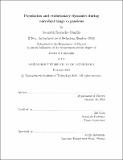| dc.contributor.advisor | Jeff Gore. | en_US |
| dc.contributor.author | Gandhi, Saurabh Rajendra. | en_US |
| dc.contributor.other | Massachusetts Institute of Technology. Department of Physics. | en_US |
| dc.date.accessioned | 2020-01-08T19:32:00Z | |
| dc.date.available | 2020-01-08T19:32:00Z | |
| dc.date.copyright | 2019 | en_US |
| dc.date.issued | 2019 | en_US |
| dc.identifier.uri | https://hdl.handle.net/1721.1/123351 | |
| dc.description | This electronic version was submitted by the student author. The certified thesis is available in the Institute Archives and Special Collections. | en_US |
| dc.description | Thesis: Ph. D., Massachusetts Institute of Technology, Department of Physics, 2019 | en_US |
| dc.description | Cataloged from student-submitted PDF version of thesis. | en_US |
| dc.description | Includes bibliographical references (pages 91-98). | en_US |
| dc.description.abstract | Spatial expansions occur across multiple scales, from the expanding range of a species to the growth of tumors and microbial biofilms. In ecology, range expansions are becoming more frequent due to environmental changes and rare long distance dispersal, often facilitated by anthropogenic activities. Simple models in theoretical ecology explain many emergent properties of range expansions, such as a constant expansion velocity, in terms of organism-level properties such as growth and dispersal rates. Moreover, the evolution and potentially even the survival of an expanding population depends on its genetic diversity, which is also predicted to reduce drastically during range expansions. However, testing these quantitative predictions in natural populations is difficult because of large environmental variability and the inability of replicating historical processes. | en_US |
| dc.description.abstract | In this thesis, I describe the use of a microbial model system to gain a deeper understanding of spatial range expansions in a controlled and replicable setting. In particularly, I study the role of cooperative growth in spatial expansions. Given the prevalence of cooperative growth in nature, understanding the effects of cooperativity is essential to managing invading species and understanding their evolution. For non-cooperative growth, the expansion dynamics are dominated by population growth at the low-density front, which pulls the expansion forward. I find these expansions to be in close quantitative agreement with the classical theory of pulled waves by Fisher and Skellam, suitably adapted to my experimental system. However, as cooperativity increases, the expansions transition to being pushed, i.e. controlled by growth in the bulk as well as in the front. | en_US |
| dc.description.abstract | In addition to the population dynamics, cooperation within populations is also predicted to significantly alter the evolutionary fate of expanding populations. This difference in evolutionary dynamics within pulled and pushed waves is also studied experimentally. | en_US |
| dc.description.statementofresponsibility | by Saurabh Rajendra Gandhi. | en_US |
| dc.format.extent | 98 pages | en_US |
| dc.language.iso | eng | en_US |
| dc.publisher | Massachusetts Institute of Technology | en_US |
| dc.rights | MIT theses are protected by copyright. They may be viewed, downloaded, or printed from this source but further reproduction or distribution in any format is prohibited without written permission. | en_US |
| dc.rights.uri | http://dspace.mit.edu/handle/1721.1/7582 | en_US |
| dc.subject | Physics. | en_US |
| dc.title | Population and evolutionary dynamics during microbial range expansions | en_US |
| dc.type | Thesis | en_US |
| dc.description.degree | Ph. D. | en_US |
| dc.contributor.department | Massachusetts Institute of Technology. Department of Physics | en_US |
| dc.identifier.oclc | 1132798385 | en_US |
| dc.description.collection | Ph.D. Massachusetts Institute of Technology, Department of Physics | en_US |
| dspace.imported | 2020-01-08T19:31:58Z | en_US |
| mit.thesis.degree | Doctoral | en_US |
| mit.thesis.department | Phys | en_US |
